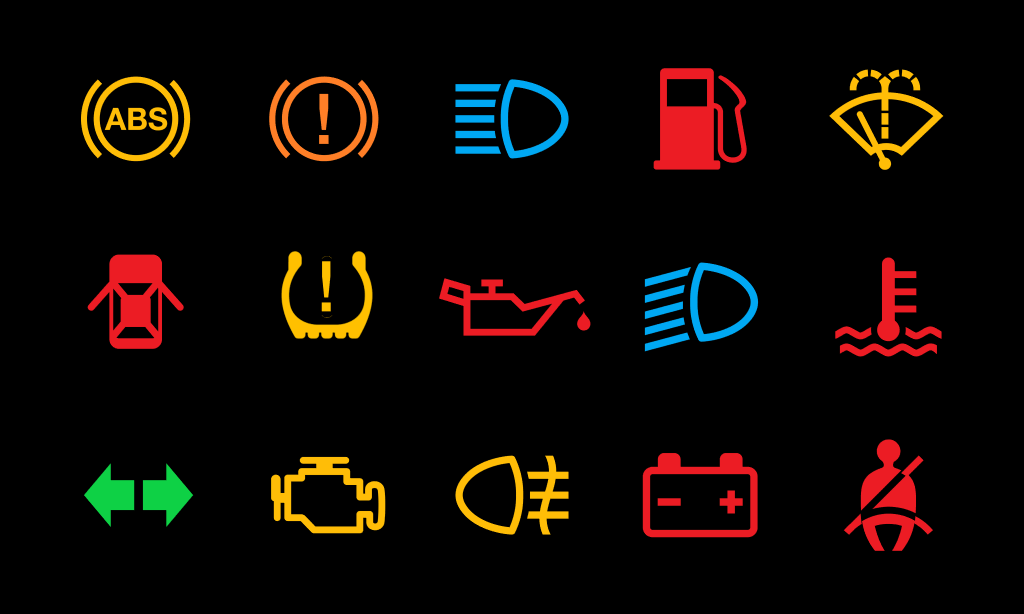Warning Lights In Your Car Dashboard, What Does It Mean?
Posted Saturday, Jan 28, 2023
As you drive down the highway and take in the beautiful scenery, a red symbol on your dashboard suddenly starts blinking. You may be unsure of what it means and may even become worried about the condition of your car. However, many dashboard warning lights on vehicles are easy to understand. Knowing what these warning lights mean can be extremely helpful if you need to pull over and call for roadside assistance.
Today's cars are equipped with digital instruments and sensors that monitor the performance and health of the vehicle. Understanding the meaning of your car's dashboard warning lights can help prevent breakdowns or major failures. By being aware of these symbols, you can take the necessary steps to keep your car running smoothly and safely.
"Different Types of Warning Symbols on a Car Dashboard"
Brack Warning Light
The brake warning light on a car dashboard is typically a red color and may appear as a circle with an exclamation point inside or a symbol of a circle with lines coming out of it, or an exclamation mark within the circle. This light is designed to alert the driver that there is a problem with the vehicle's brake system, such as low brake fluid, worn brake pads, or a malfunctioning brake system component.
When the brake warning light appears, it is important to take immediate action. If the brake pedal feels spongy or soft, this is an indication of low brake fluid, which can cause the brake system to fail. If the brake pedal feels normal, it could be a sign of worn brake pads, which can also cause the brake system to fail.
If the brake warning light comes on, it is important to have the vehicle inspected by a qualified mechanic as soon as possible. Driving with a malfunctioning brake system can be dangerous and can lead to a loss of braking power or complete brake failure, putting you and others at risk.
It is also important to note that if the brake warning light comes on along with the ABS (Anti-Lock Braking System) warning light, it indicates a problem with the ABS system, which is responsible for preventing the wheels from locking up during hard braking. This could be caused by a malfunctioning sensor or a problem with the ABS module and should be addressed by a professional.
In conclusion, the brake warning light on a car dashboard is an important safety feature that alerts the driver when there is an issue with the brake system. If this light comes on, it is important to have the vehicle inspected by a qualified mechanic as soon as possible to ensure that the brake system is working properly, and to avoid a potential accident. For more information on rack warning lights please read the article on AutoGuru.
Airbag Warning Light

The Airbag Warning Light, also known as the SRS (Supplemental Restraint System) Warning Light, is a critical safety feature on a car's dashboard. This light is typically a yellow or orange color and may appear as a person sitting in a seat with a circle and an exclamation point above them.
This light indicates that there is a problem with the airbag system in your car, which is responsible for deploying the airbags in the event of a collision. The system could have a malfunctioning sensor, a wiring issue, or a problem with the airbag module. If the light stays on, it means that the airbags may not deploy in the event of a collision, putting you and your passengers at risk.
If the airbag warning light comes on, it is important to have your car inspected by a professional mechanic as soon as possible. It is not safe to drive a car with a malfunctioning airbag system, so it's best to have it repaired before using the car again.
It's important to note that some cars have a "Passenger Airbag Off" light that will turn on when the seat is empty, this is not an indication of a malfunction but rather a feature to disable the airbag when the seat is empty to avoid injury to small children or pets.
In summary, the airbag warning light is a critical safety feature that alerts the driver to potential problems with the airbag system. If the light comes on, it is important to have the car inspected by a professional mechanic as soon as possible to ensure that the airbags will deploy correctly in the event of a collision. Here you can watch a short video on how to easily fix an Airbag Warning Light.
Power Steering Warning light

The Power Steering Warning Light is a dashboard warning light that typically appears as a steering wheel symbol. It is designed to alert the driver to a problem with the power steering system in the vehicle. The power steering system is responsible for making it easier for the driver to turn the steering wheel, and when it is not working properly, it can make the vehicle more difficult to steer.
When the Power Steering Warning Light comes on, it is important to pay attention to it and to have the vehicle inspected as soon as possible. The cause of the problem could be anything from low power steering fluid levels to a malfunctioning power steering pump, or even a problem with the steering rack or column.
If the light comes on, it is recommended to check the power steering fluid level and top it up if necessary. If the light remains on after topping up the fluid, or if there is no fluid leak, it is best to have the car inspected by a mechanic as soon as possible.
Driving with a malfunctioning power steering system can be dangerous, as it can make the vehicle difficult to steer, especially at low speeds or when making tight turns. It's important to address the issue as soon as possible to avoid any potential accidents or further damage to the car.
In summary, the Power Steering Warning Light is an important indicator of a problem with the car's power steering system. If it comes on, it's important to pay attention to it, check the power steering fluid level, and have the vehicle inspected by a mechanic as soon as possible to avoid any potential danger while driving.
Engine Temperature Warning Light
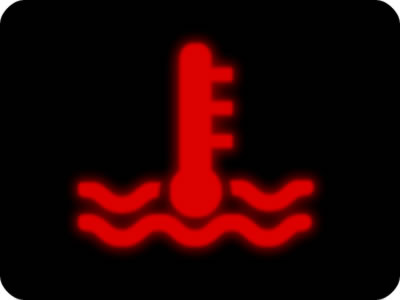
The Engine Temperature Warning Light, also known as the coolant temperature warning light, is a dashboard indicator that illuminates when the engine is running at a high temperature. This light is typically represented by a thermometer symbol or an "H" and is usually red or orange in color. It is important to pay attention to this light as it indicates that the engine is overheating and immediate attention is required.
When the engine temperature warning light comes on, it is an indication that the coolant temperature has exceeded the normal range. This can be caused by a variety of issues such as a low coolant level, a malfunctioning thermostat, a clogged radiator, or a faulty water pump. If the light comes on, you should pull over and turn off the engine as soon as possible to avoid any damage.
If the light comes on, it is important to check the coolant level immediately and add more if necessary. If the light remains on after adding coolant, it is best to have the car serviced by a mechanic as soon as possible to diagnose and fix the problem. Running the engine while it is overheating can cause serious damage to the engine and other components, such as the head gasket, cylinder head, and pistons.
In summary, the engine temperature warning light is an important indicator that alerts the driver when the engine is overheating. If this light comes on, it is important to take immediate action to avoid any further damage to the engine. By monitoring this light and addressing any issues promptly, you can help ensure the longevity and reliability of your vehicle.
Oil Warning Light

The Oil Warning Light is typically a red color and may appear as an oil can or oil pressure gauge symbol on your car's dashboard. This light is designed to alert you when there is a problem with your car's oil system. It typically indicates that the oil pressure is low, which can be caused by a variety of issues such as a low oil level, a clogged oil filter, or a failing oil pump.
When the Oil Warning Light comes on, it's important to take immediate action. You should stop the car as soon as it is safe to do so and check the oil level. If the oil level is low, add oil. However, if the light remains on after adding oil, or if the oil level is already full, it is recommended to have the car inspected by a mechanic as soon as possible.
Running your car without enough oil pressure can cause serious damage to the engine. It can also cause the engine to seize and fail completely, which can be costly to repair. Therefore, it's important to take the Oil Warning Light seriously and address the problem as soon as it appears.
In conclusion, the Oil Warning Light is a critical indicator of the health of your car's oil system. It alerts you when the oil pressure is low and prompt action is required. By taking immediate action when the light appears, you can help protect your engine and avoid costly repairs.
Seat Belt Reminder Light
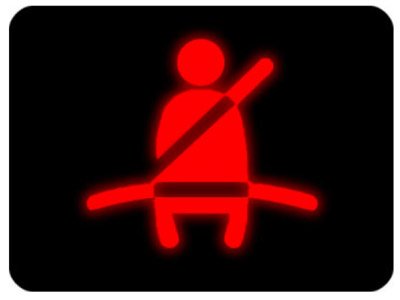
The Seat Belt Reminder Light is a safety feature that is designed to remind the driver and passengers to fasten their seat belts before driving. This light typically appears on the dashboard as an illuminated symbol of a person wearing a seat belt.
When the car is started, the Seat Belt Reminder Light will turn on for a few seconds to remind the driver and passengers to fasten their seat belts. If the seat belts are not fastened, the light will stay on or flash until the seat belts are properly fastened. Once the seat belts are fastened, the light will turn off.
It's important to note that the Seat Belt Reminder Light is not an indicator of a malfunction or problem with the seat belts. It is simply a reminder to use them for your own safety and the safety of others. It is important to heed the warning and fasten your seatbelt before the car starts to move.
It is important to obey the reminder light to ensure the safety of yourself and others in the car. If the light is on and you are unable to fasten the seatbelt, please check for any possible obstruction, or malfunction and have it checked by a mechanic.
Door Open warning Symbol

The door open warning symbol on a car dashboard is a visual indicator that one or more of the doors on the vehicle are not fully closed. This symbol is typically represented by a picture of a door with an open arrow pointing toward it. When this symbol is illuminated, it is an indication that the driver should check the doors of the car to ensure that they are properly closed before driving.
Failing to close a door properly can create a safety hazard while driving, as the door may open unexpectedly or impede the driver's visibility. Additionally, leaving a door open while the car is running can drain the battery and cause other electrical issues.
It's important to check the doors and close them properly when you see this warning symbol on your dashboard. If the symbol remains on after all doors are closed, it may indicate a problem with the door latch or switch, and you should have your vehicle inspected by a mechanic as soon as possible.
Hood Open Symbol

The hood open symbol is typically a picture of a car with its hood lifted. It is usually found on the dashboard of a vehicle and serves as a reminder to the driver that the hood of the car is not securely closed.
This symbol is important as it is a safety feature that alerts the driver to check the hood of the car before driving. If the hood is not properly closed, it could fly open while the car is in motion, causing damage to the car or even injury to the driver or passengers.
When this symbol illuminates on the dashboard, it is important to stop the car and check the hood to ensure it is securely closed. If it is not, close the hood properly and ensure it is latched securely before driving. If the symbol remains on even after the hood is closed, it may indicate a malfunction in the hood latch or sensor and should be inspected by a mechanic as soon as possible.
It's important to note that this symbol may vary depending on the make and model of your car. Also, some cars might have a warning chime that will go off when you drive with the hood open.
Steering Wheel Lock Symbol

The Steering Wheel Lock Symbol on a car dashboard is typically a picture of a steering wheel with a red or yellow padlock symbol. This warning light indicates that the car's steering wheel lock mechanism is engaged or malfunctioning. This feature is designed to prevent the steering wheel from turning when the car is not in use, as an added security measure.
When this warning light appears on the dashboard, it typically indicates that the steering wheel is locked and the car will not start. If this happens, the owner will not be able to steer the car. To fix this issue, the owner should refer to their car's manual and try to disengage the steering wheel lock. If the problem persists, it may require the attention of a professional mechanic.
It is important to note that if this light comes on while driving, it could mean that there is a problem with the steering wheel lock mechanism, it is recommended to stop the car safely and get it checked by a mechanic as soon as possible.
Automatic Gear Box Warning Symbol

The Automatic Gear Box Warning Symbol is a visual indicator that appears on the dashboard of a car with an automatic transmission. This symbol is typically a gear with an exclamation point inside, and it is designed to alert the driver that there is a problem with the transmission system.
If this symbol appears on your dashboard, it is important to take it seriously and have your car serviced as soon as possible. This warning can indicate a wide range of issues, such as low transmission fluid, a malfunctioning sensor, or a problem with the transmission itself. In some cases, the symbol may indicate a minor issue that can be easily fixed, but in other cases, it may indicate a more serious problem that requires extensive repairs.
It is important to note that if the Automatic Gear Box Warning Symbol appears on your dashboard, you should not continue to drive the car. Operating a car with a malfunctioning transmission can cause serious damage to the vehicle and may also put yourself and other drivers at risk. Instead, you should pull over and have your car towed to a reputable repair shop for further diagnosis and repairs.
When you take your car to the mechanic, it is important to inform the mechanic of the warning symbol, and if possible, the conditions under which the warning appeared, such as the speed, temperature, or engine RPM. This will help the mechanic quickly identify the problem and make the necessary repairs to get you back on the road safely.
In conclusion, the Automatic Gear Box Warning Symbol is a vital indicator that alerts the driver to a problem with the transmission system. If this symbol appears on your dashboard, it is important to take it seriously, stop driving the car and have it serviced as soon as possible to avoid further damage and to ensure safe driving.
Battery Charge Warning Light
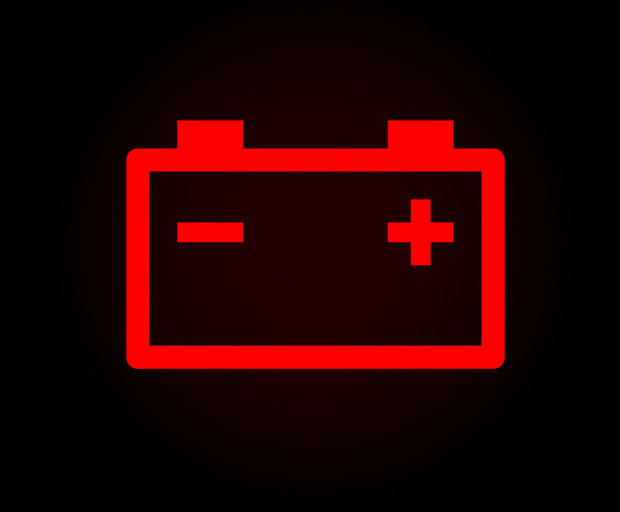
The Battery Charge Warning Light, also known as the Charging System Warning Light, is an important indicator that appears on a car's dashboard. This light is typically a red or yellow color and may appear as a battery symbol. It indicates that the charging system of the car is not working properly and the battery may be dead or dying.
When the light comes on, it's important to pay attention to it as it can indicate a variety of problems with the charging system such as a malfunctioning alternator, a loose or corroded battery cable, or a faulty voltage regulator. This can cause the battery to not charge while the car is running, or not hold a charge when the car is off, making it difficult to start the car.
If the light comes on and stays on while you're driving, you should have your car inspected by a mechanic as soon as possible. In some cases, the light may come on temporarily, such as when the car is first started, this is normal and indicates that the charging system is checking itself.
It's important to keep in mind that if the battery charge warning light comes on and stays on, the battery may not have enough power to start the car or it may not hold a charge for very long, which can leave you stranded.
In summary, the battery charge warning light is a crucial indicator that alerts the driver of a potential issue with the charging system of the car. If this light comes on and stays on, it's important to have your car inspected by a mechanic as soon as possible to avoid being stranded or having to replace the battery.
Low Fuel Warning Light
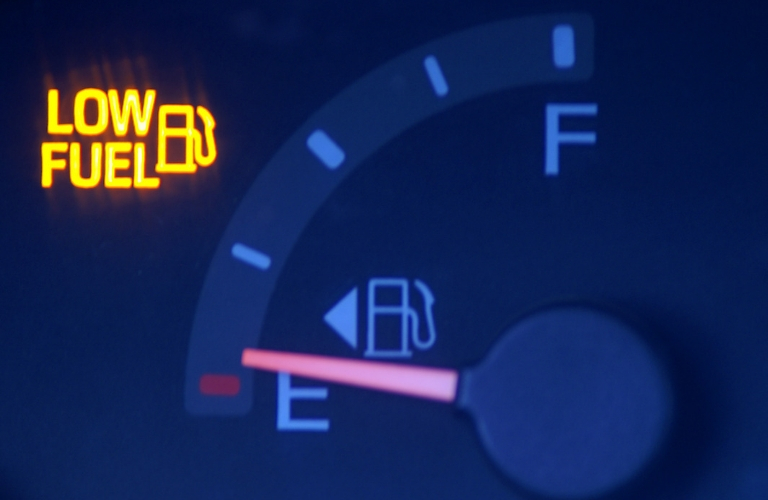
The Low Fuel Warning Light is a common warning light that appears on a car's dashboard. It typically appears as a gas pump symbol and is designed to alert the driver that the fuel level in the tank is getting low and that it's time to refuel the vehicle. This light will typically come on when the fuel level reaches around one-eighth of a tank or less.
It is important to pay attention to this warning light and not to ignore it as running out of fuel can damage the fuel pump, cause the engine to stall, or even leave you stranded on the road. When this warning light appears, it's a good idea to refuel the car as soon as possible to avoid running out of gas.
It's also a good idea to keep track of your fuel consumption and to plan your refueling stops accordingly to avoid the low fuel warning light from coming on unexpectedly.
In conclusion, the Low Fuel Warning Light is an important warning light on a car dashboard that alerts the driver that the fuel level is getting low and it's time to refuel the vehicle. It's important to pay attention to this light, and take appropriate action by refueling the vehicle in order to avoid running out of gas and causing damage to the vehicle.
Low Beam Indicator
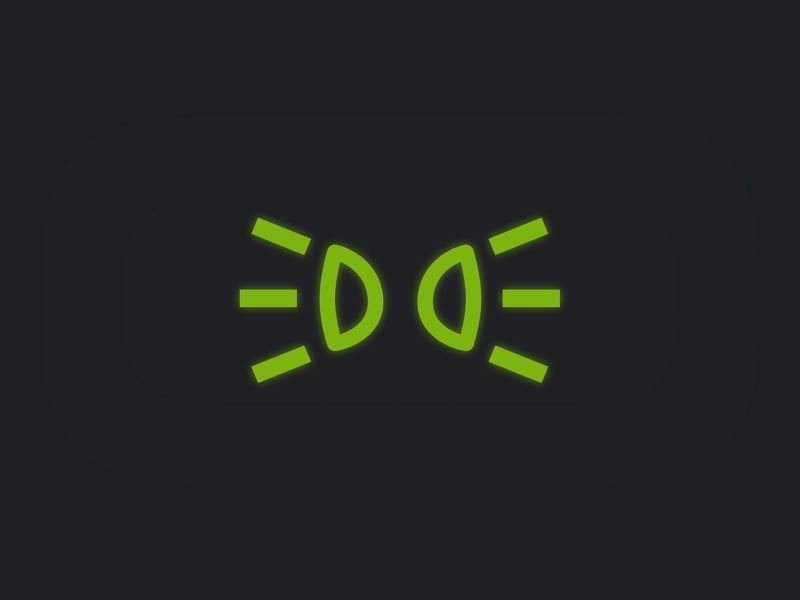
The Low Beam Indicator is a warning light that appears on the dashboard of a car when the low-beam headlights are in use. The indicator is typically a symbol of a headlight or the letters "LOW" and it is usually located in the vicinity of the headlight control on the dashboard.
The low-beam headlights are used for normal driving conditions and are designed to provide a good balance of visibility and reduced glare for oncoming drivers. When the low beam indicator is illuminated, it means that the low beam headlights are turned on and provide illumination to the road ahead.
It is important to note that if the low beam indicator is not illuminated, it means that the low beam headlights are not in use and you should switch them on for safer driving. Also if the indicator light is flashing or blinking, it may indicate a malfunction with the low-beam headlights and you should have your car checked by a mechanic as soon as possible.
High Beam Indicator

The High Beam Indicator is a light on the car's dashboard that is typically represented by a symbol of a headlight with a line above it. This light is used to indicate when the high beams on the car's headlights are turned on. High beams provide brighter light than low beams and are used when driving on dark roads with little or no street lighting.
When the High Beam Indicator is illuminated, it means that the high beams are currently in use. It is important to note that when this light is on, it is necessary to dim the headlights when approaching other vehicles on the road, as high beams can be blinding to other drivers.
Additionally, many cars now also come equipped with a feature called automatic high beams, which automatically switches the headlights between high and low beams depending on the presence of other vehicles. If this feature is active, the high beam indicator will blink rapidly to remind the driver that the high beams are on and should be dimmed when approaching other vehicles.
It's important to keep an eye on high beam indicator lights and use high beams responsibly, as it helps to improve visibility on the road while not disrupting other drivers.
Exterior Light Fault

The Exterior Light Fault warning light on a car dashboard typically appears as a symbol of a headlight or a lightbulb with a triangle or exclamation point next to it. This light indicates that there is an issue with one or more of the exterior lights on the vehicle, such as a headlight, taillight, or turn signal. It could mean that light is burned out, or that there is a problem with the wiring or the light switch.
When the Exterior Light Fault warning light is illuminated, it is important to check all of the exterior lights on the vehicle to see if any are not working properly. If a light is burned out, it should be replaced immediately. If the problem persists, it is recommended to take the vehicle to a mechanic or a dealership to have it checked and repaired.
It is important to note that driving with non-functioning exterior lights can be dangerous, as it can make the vehicle less visible to other drivers on the road. It can also result in a traffic violation. So, it is important to address the issue as soon as possible.
Tire Pressure Warning Light

The Tire Pressure Warning Light is a feature on many modern cars that alerts the driver when the tire pressure is low. It is typically represented on the dashboard by a symbol of a horseshoe with an exclamation point inside.
When this light appears on the dashboard, it is an indication that at least one of the tires on your vehicle has low air pressure and needs to be inflated. Low tire pressure can have a number of negative effects on your car, such as decreased fuel efficiency, uneven tire wear, and decreased handling and stability.
It's important to note that driving on under-inflated tires can also lead to a blowout, which can be dangerous. You should address this warning immediately by checking your tire pressure and inflating the tires if needed. You can check the tire pressure using a tire gauge, which can be purchased at most auto parts stores.
It's also important to be aware that the tire pressure warning light might come on due to a malfunction in the tire pressure monitoring system (TPMS) or a sensor. In this case, you'll need to have the system inspected by a professional to identify the problem and get it fixed.
In general, it's a good idea to check your tire pressure regularly and be aware of the warning lights on your car's dashboard. By keeping an eye on your tire pressure and addressing any issues as they arise, you can help ensure the safety of you and your passengers and prolong the life of your tires.
Security Indicator Light
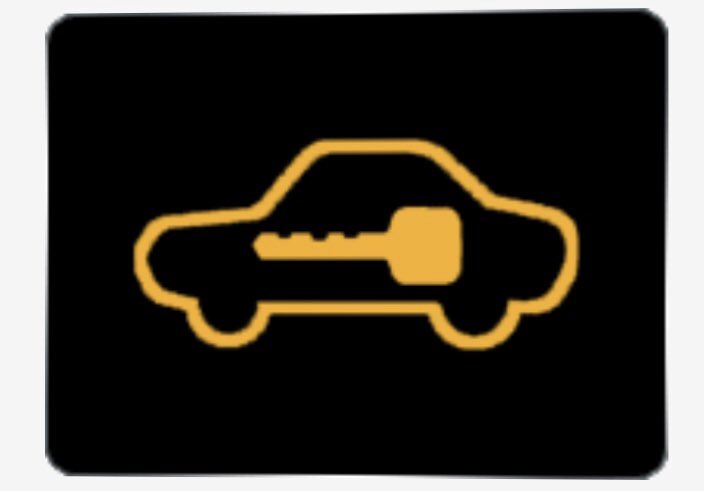
The Security Indicator Light, also known as the "theft deterrent" light, is a small LED light located on the dashboard of your car. It's typically represented by a car with a padlock symbol, and it serves as a visual indication that your car's security system is active and functioning properly.
When you turn on your car's ignition, this light will illuminate for a few seconds and then turn off. This is a normal indication that the system is performing a self-check. However, if this light stays on or begins to flash, it could indicate a problem with the security system.
If the Security Indicator Light stays on, it may indicate that there is a malfunction with the system or that the system has been triggered. In this case, you should have the car checked by a professional to determine the cause of the problem and have it fixed.
If the light flashes, it could indicate that the system has been triggered and that someone is trying to break into your car. If this happens, you should take immediate action to secure your car and call the police.
The Security Indicator Light is an important feature that helps protect your car and its contents. It alerts you to potential problems with the security system, so you can take action to prevent theft and keep your car safe.
Anti Lock Brack System Warning Light

The Anti-Lock Brake System (ABS) Warning Light is a dashboard warning light that is typically represented by a circular symbol with the letters "ABS" inside. It is designed to alert the driver when there is a problem with the car's ABS system. The ABS system is a safety feature that helps prevent the wheels of a car from locking up during sudden braking, which can cause the vehicle to skid out of control.
When the ABS Warning Light appears on the dashboard, it typically indicates that there is a malfunction in the ABS system. This can be caused by a variety of issues, such as a malfunctioning sensor, a low brake fluid level, or a problem with the ABS control module.
If the ABS Warning Light comes on, it is important to take it seriously and have the car inspected by a mechanic as soon as possible. In the meantime, the car's regular brake system will still function and you can still brake normally, but you may not have the benefit of the ABS system during emergency braking.
It is also important to keep in mind that the ABS Warning Light is separate from the regular brake warning light and if the brake warning light comes on, it indicates a more serious problem with the brake system, and you should immediately stop the car in a safe place and call for a tow.
In summary, the Anti-Lock Brake System Warning Light is a warning light that appears on the dashboard of a car when there is a problem with the ABS system. It is important to take this warning seriously and have the car inspected by a mechanic as soon as possible to ensure the safety of the vehicle.
Washer Fluid Indicator Light

The Washer Fluid Indicator Light is a small, usually yellow or orange, light on the car dashboard that is shaped like a fluid container with a windshield or a droplet symbol. This light is designed to alert the driver when the washer fluid level in the vehicle is low. The washer fluid is used to clean the windshield and other windows, and it is essential for maintaining clear visibility while driving.
When this light turns on, it is an indication that the washer fluid reservoir needs to be refilled. If the light stays on, it means that the washer fluid is extremely low and needs to be refilled as soon as possible. It's important to note that running out of washer fluid can cause damage to the windshield wipers and washer system.
To refill the washer fluid, simply open the hood of the car and locate the washer fluid reservoir, which is usually located near the windshield. Check the level of the fluid and add more as necessary, being sure to use the correct type of fluid for your vehicle.
It's a good practice to regularly check the washer fluid level, especially before a long journey, to ensure that you have enough fluid to keep your windshield clean and clear. This small, yet important, light is a reminder to keep your visibility clear and stay safe while driving.
Lane Departure Warning Light
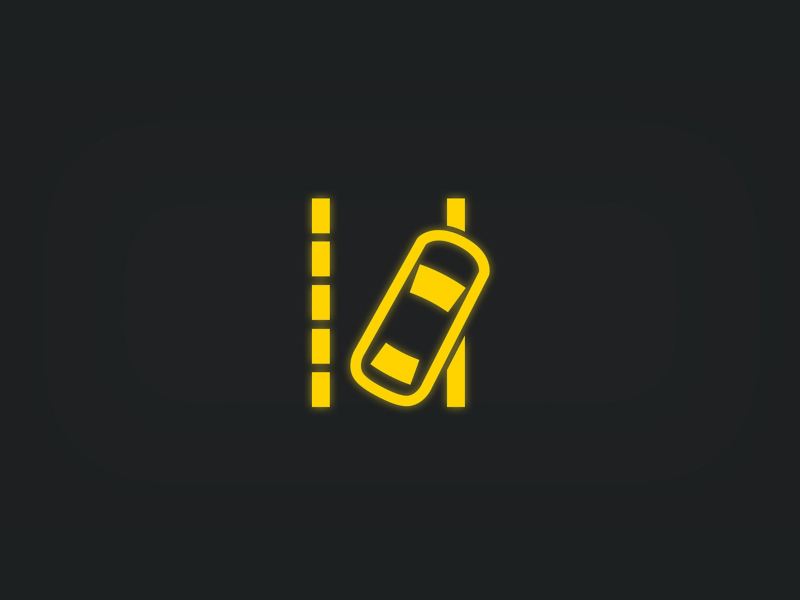
The Lane Departure Warning Light, also known as Lane Keeping Assist, is a feature that helps prevent accidental lane departures on the road. This light typically appears as a symbol of a car with arrows on either side and is located on the dashboard of the vehicle.
When activated, the system uses cameras or sensors to detect the lane markings on the road and will alert the driver with a visual and/or auditory warning if the vehicle begins to drift out of its lane without the turn signal being activated. This feature is designed to help the driver stay in their lane and reduce the risk of accidents caused by unintentional lane changes.
It's important to note that the Lane Departure Warning Light is not a substitute for safe driving practices, and drivers should always pay attention to the road and use their turn signals when changing lanes. Additionally, the system may not work properly in certain conditions, such as poor visibility or if the lane markings on the road are faded or obscured.
In summary, Lane Departure Warning Light is a car dashboard feature that helps drivers stay in their lane and prevent unintentional lane departures. It uses cameras or sensors to detect the lane markings on the road and alerts the driver with a visual and/or auditory warning when the vehicle begins to drift out of its lane without the turn signal being activated. It's important to note that this feature is not a substitute for safe driving practices, and drivers should always pay attention to the road and use their turn signals when changing lanes.
Cruise Control Light
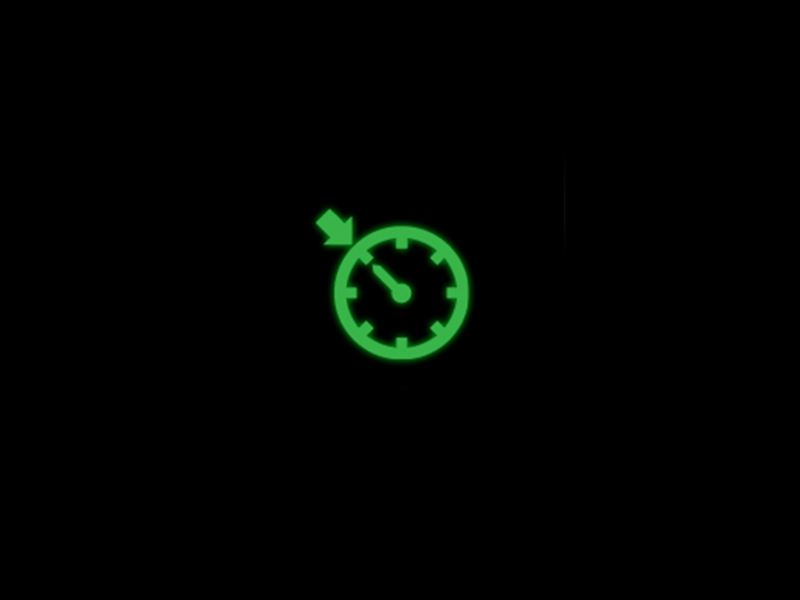
The cruise control light on a car dashboard is typically represented by a symbol of a car with wavy lines behind it. This light is an indicator that the cruise control system is active or available to use. When the cruise control is turned on, the light will illuminate, and when it is turned off, the light will go out.
Cruise control is a feature that allows the driver to maintain a set speed without having to continuously press the accelerator. This can be especially useful for long drives on the highway as it reduces driver fatigue.
It's important to note that this light does not indicate a problem or malfunction, it simply indicates the status of the cruise control system. If the cruise control light does not turn on or function properly, it may indicate a problem with the system and it is recommended to have the car inspected by a mechanic.
Collision Warning light
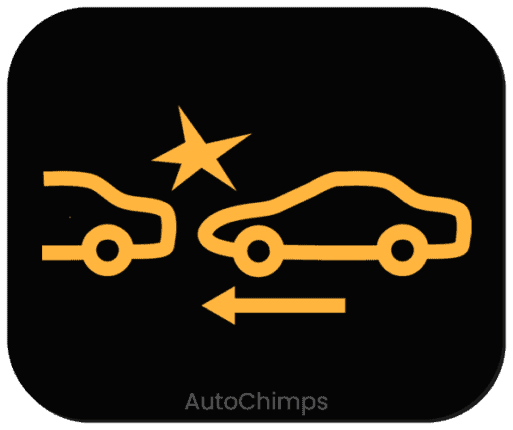
The Collision Warning Light is a safety feature found on many modern cars that alerts the driver of potential collision hazards. It typically appears as a bright, flashing symbol of a car or an exclamation point, and is usually located on the dashboard or the windshield in the driver's field of view.
When the Collision Warning Light is activated, it indicates that the car's sensors have detected a potential collision hazard, such as another vehicle or a pedestrian. The system then uses a combination of visual and audio alerts to alert the driver to take action.
The collision warning system can be activated by the radar or camera sensor which are usually located in the front of the car, the system uses these sensors to detect the distance and speed of the object in front of the car, if the system detects that the distance between the car and the object is too close and the speed difference is high the system will activate the light and sound an alarm to warn the driver.
It is important to note that the Collision Warning Light is not a substitute for safe driving practices and should never be ignored. If the light comes on, drivers should take appropriate action, such as braking or steering to avoid a potential collision.
If the Collision Warning Light comes on and stays on, it may indicate a malfunction in the car's sensor system. In this case, it is important to have the car checked by a qualified technician as soon as possible to ensure that the system is working properly.
In conclusion, the Collision Warning Light is an important safety feature that can help alert drivers to potential collision hazards and reduce the risk of accidents. It is important to understand what the light means and to take appropriate action when it is activated.
Speed Limiter Light
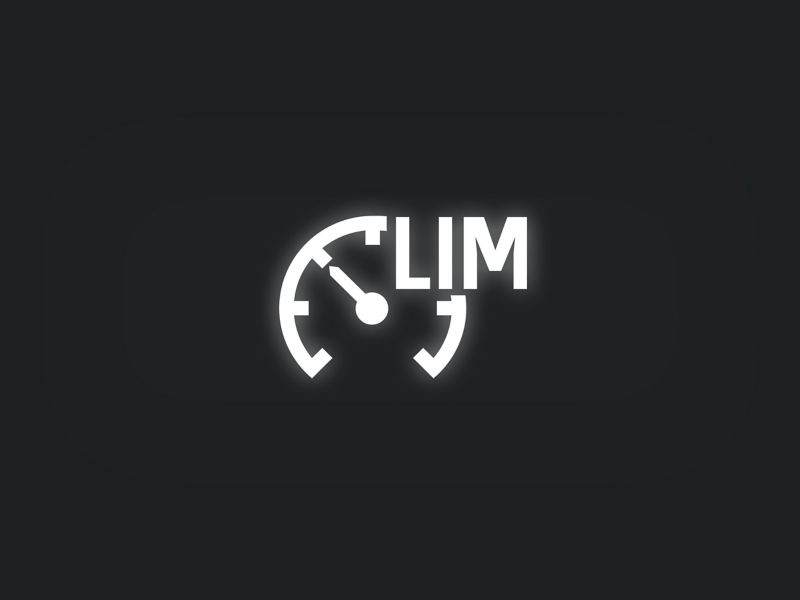
The Speed Limiter Light is a feature found on some cars that helps drivers maintain a safe and legal speed while on the road. This light typically appears as a symbol of a car with a diagonal line through it and may be accompanied by the letters "SL" or "LIM". When this light is illuminated, it indicates that the car's speed limiter is active and the vehicle's speed will be restricted to a certain maximum speed set by the driver or the manufacturer.
The speed limiter function can be activated manually by the driver using the car's controls or it may be set automatically by the car's onboard computer. The purpose of this feature is to help drivers avoid exceeding speed limits, reduce fuel consumption and reduce the risk of accidents caused by excessive speed.
When the Speed Limiter Light is on and the driver attempts to accelerate beyond the set speed, the engine's power will be reduced, preventing the car from going faster. Some cars may also have a beep or warning sound to alert the driver.
It's important to note that this light and the speed limiter function are not a substitute for paying attention to posted speed limits and driving conditions. Drivers should always use their own judgment and obey traffic laws while on the road.
Hill Descent light
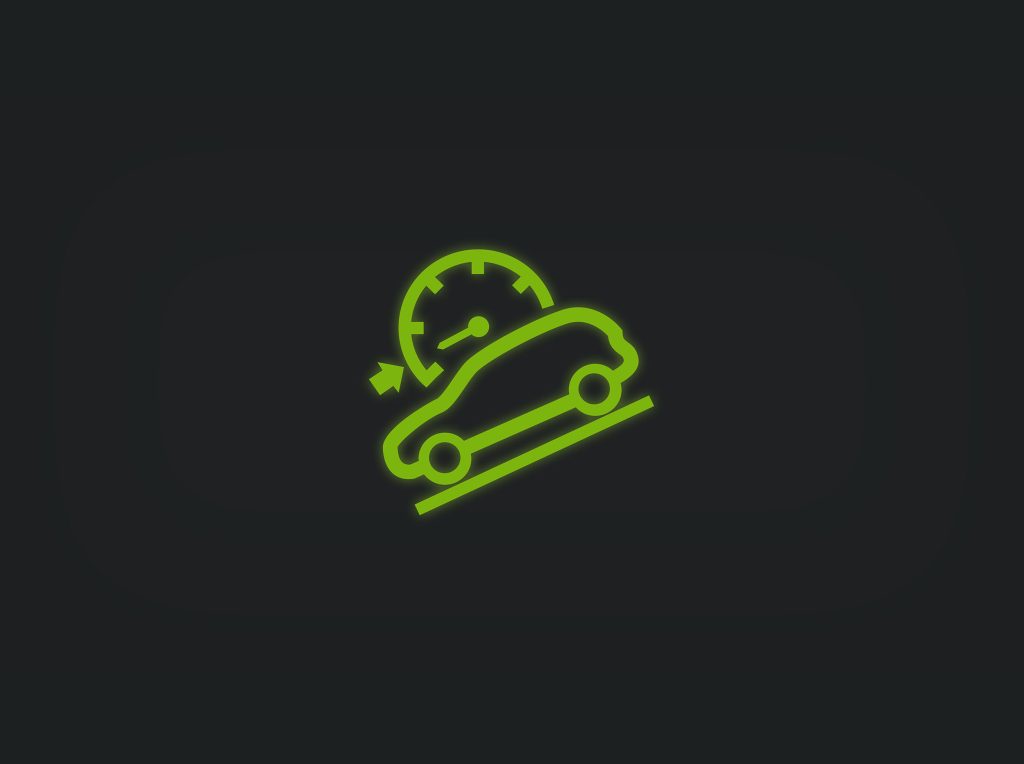
The Hill Descent Light is a feature found on some car dashboards, typically on vehicles that are equipped with four-wheel drive or all-wheel drive. It is a visual indicator that is designed to help the driver maintain control when driving downhill on steep terrain.
When the Hill Descent Light is activated, it typically appears as an icon of a car going downhill with an exclamation mark. It is generally activated when the driver is going downhill and the vehicle's speed is above a certain threshold.
The Hill Descent Light is a reminder to the driver to use caution and to employ the vehicle's Hill Descent Control (HDC) system if it is equipped. The HDC system is designed to automatically control the vehicle's speed and braking when going downhill, reducing the risk of skidding or losing control.
It is important to note that the Hill Descent Light is not a warning light and is not indicating a problem with the vehicle. It is simply a reminder to the driver to use caution and to be aware of their surroundings when driving on steep terrain.
Lane Assist Light

The Lane Assist Light, also known as Lane Departure Warning (LDW) system, is a feature found on some cars that helps the driver stay within their lane of travel. This light is typically a yellow or orange color and may appear as an icon of a car between two lines. It is typically located on the dashboard or instrument cluster of the car.
When the car detects that it is drifting out of its lane, this light will turn on as a visual warning to the driver. In some cases, the system may also provide an audible warning or vibrate the steering wheel to alert the driver.
The Lane Assist Light is designed to help prevent accidents caused by lane departure and drowsy or distracted driving. It can be particularly useful on long trips or on roads with a lot of traffic. It is important to note that this feature is not a substitute for safe driving practices and the driver should always pay attention to the road and obey traffic laws.
This is a very important feature as it keeps the driver alert, in case they are drifting out of their lane without noticing it, also it helps to prevent accidents caused by lane departure.
